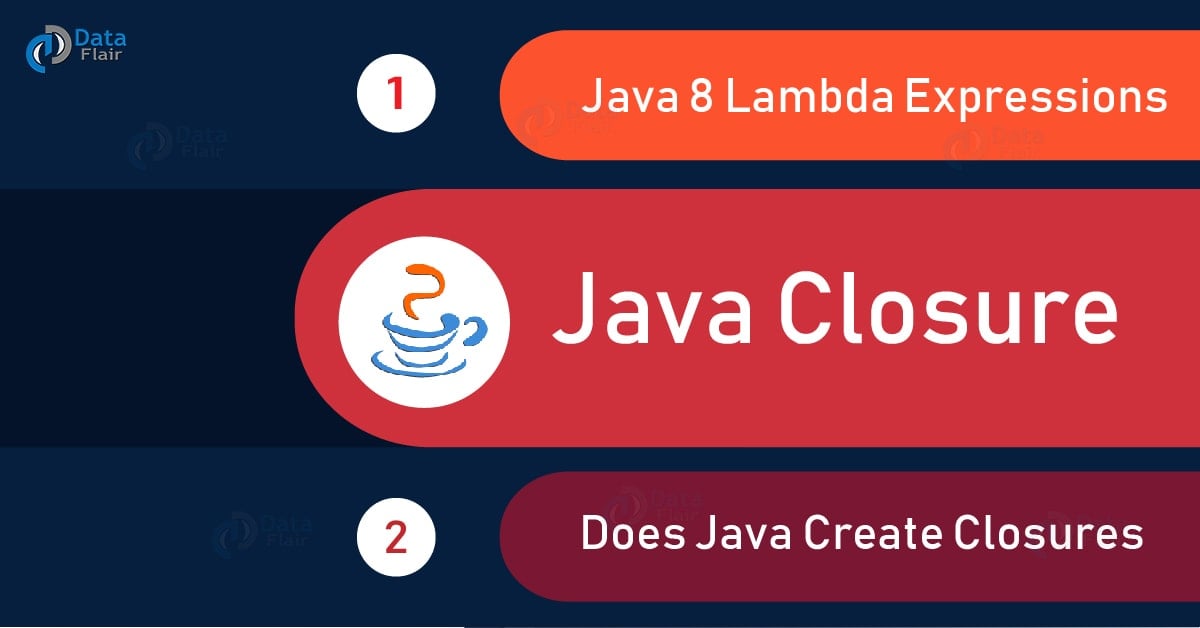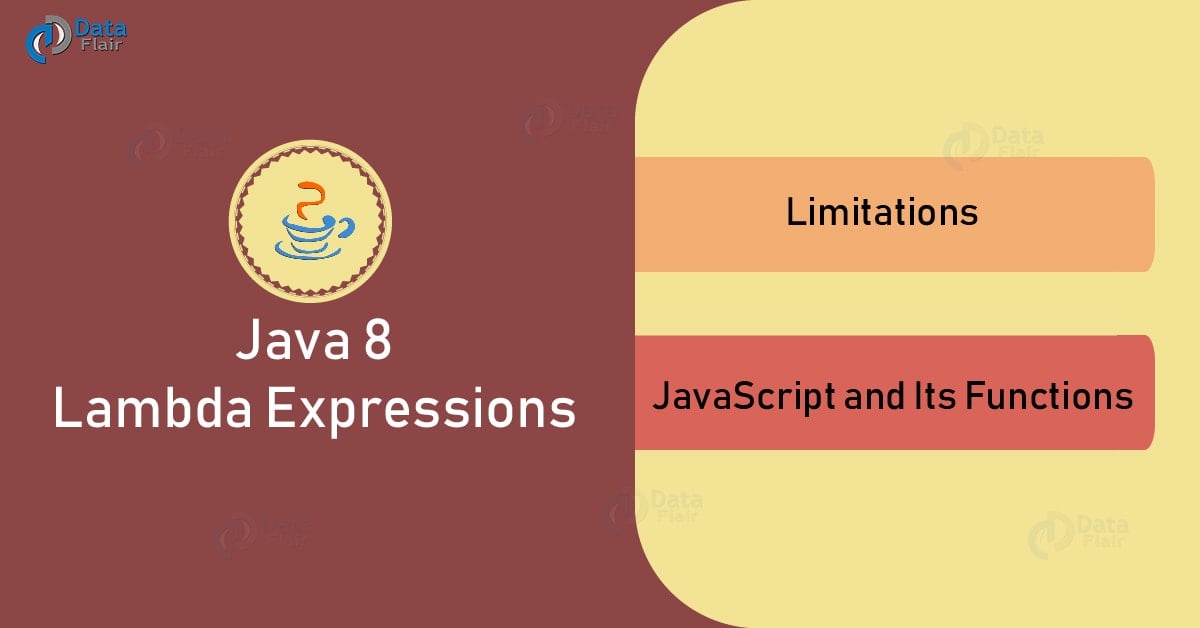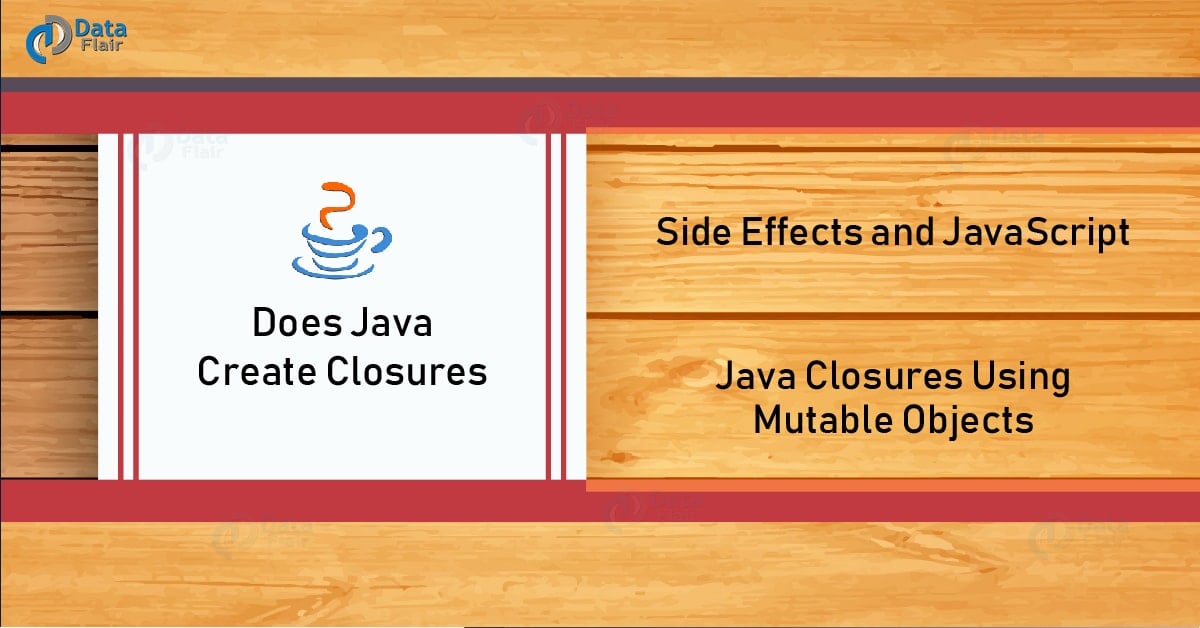What is Java Closure | Java 8 Lambda Expressions
Free Java courses with 37 real-time projects - Learn Java
1. Objective
In our last Tutorial, we discussed final keywords in Java. Today, we will discuss Java Closure. Here, in this article, we will first see the introduction to closure in Java. Moreover, we will learn how Java create Closure. Along with this, we will discuss Java 8 Lambda expression. Also, the limitations of Java 8 Lambda and JavaScript functions. At last, we will see Java Closure using Mutable objects.
So, let us start Java Closure.
2. What is Java Closure?
Suppose we wish to make an easy thread that solely prints one thing on the console:
int answer = 14;
Thread t = new Thread(
() -> System.out.println("The answer is: " + answer)
);In this Java Closure article, we will prefer to answer this question, discussing the limitations of Java lambda expressions and consequences on the approach Java implements closures is the answer to this question, however, there are limitations once we compare them with different languages. On the opposite hand, these limitations are thought-about negligible.
Do you know What is Design Patterns in Java?
3. What is Java 8 Lambda Expressions?
int answer = 14; Thread t = new Thread(new Runnable() "> });
Since Java 8, the previous example could be written using a lambda expression.
Now, we have a tendency to all know that Java 8 lambda expressions don’t seem to be only about reducing the verbosity of your code; they also have many different new features. What is more, there are between the implementation of anonymous classes and lambda expressions.
But, the main purpose we might highlight here is that considering however they act with the enclosing scope, we are able to think about them even as a compact approach of making anonymous classes of interfaces, like Runnable, Callable, Function, Predicate, and so on. I
a. Java 8 Lambda Limitations
- The intromission scope for Lambda expressions in Java will solely access to the ultimate (or effectively final) variables.
For example, take into account the subsequent example:
void fn()
Compilation won’t be done as incrementation of myVar is final.
Read Java Language Keywords – Top 4 Keyword in Java (Part 2)
b. JavaScript and Its Functions
Functions and lambda expressions in JavaScript use the conception of closures:
A closure may be a special kind of object that combines 2 things: a function, and therefore the environment during which that function was created. It contains local variables. In fact, the previous example works well in JavaScript.
function fn() { // the intromission scope
var myVar = 42;
var lambdaFun = () => myVar;
myVar++;
console.log(lambdaFun()); // it prints 43
}4. Does Java Create Closures?
The only value of free variables is allowed by Java to allow them to be used within lambda expressions. Albeit there was an increment of myVar, the lambda function would still return 42. The compiler avoids the creation of these incoherent scenarios, limiting the kind of variables which will be used within lambda expressions (and anonymous classes) to only final and effectively final ones. In fact, closures, in their lot of theoretical acceptation, capture solely the value of free variables. In pure functional languages, this is often the sole issue that ought to be allowed, keeping the referential transparency property.
a. Side Effects and JavaScript
To better understand the concept of closures in Java, take into account currently the subsequent JavaScript code (forgive that in JavaScript, this may be worn out an awfully compact approach, however, we would like it to seem like Java for a comparison):
Explore Java Functional Interface | Lambda Expression in Java
function createCounter(initValue) { // the intromission scope
var count = initValue;
var map = new Map();
map.set('val', () => count);
map.set('inc', () => count++);
return map;
}v = createCounter(42);
v.get(‘val’)();
v.get(‘inc’)();
v.get(‘val’)();
The first function in Java Closure has side effects that change the results of the other. An important fact to note here is that createCounter’s scope still exists once its termination, — and is at the same time employed by the 2 lambda functions.
Now let’s attempt to do a similar issue in Java:
public static Map createCounter(int initValue) { // the intromission scope
int count = initValue;
Map map = new HashMap<>();
map.put("val", () -> count);
map.put("inc", () -> count++);
return map;
}This code does not compile as a result of the second lambda perform is making an attempt to change the variable count.
Java stores function variables (e.g. count) within the stack; those remove with the termination of createCounter. The created lambdas use copied versions of count. If the compiler allowed the second lambda to change its traced version of count, it’d be quite confusing.
b. Java Closures Using mutable Objects
The value of a user variable copy to the lambda or anonymous class. During this case, solely the reference would copy, and that we might look at things a bit otherwise.
Let’s discuss Java Semaphore – Working & Constructor
We might just about emulate the behavior of JavaScript’s closures within the following way:
private static category MyClosure
}
public static Map createCounter(int initValue) {
MyClosure closure = new MyClosure(initValue);
Map counter = new HashMap<>();
counter.put("val", () -> closure.value);
counter.put("inc", () -> closure.value++);
return counter;
}Supplier[] v = createCounter(42);
v.get(“val”).get(); // returns forty two
v.get(“inc”).get(); // returns forty two
v.get(“val”).get(); // returns forty three
Java Closures are employed by JavaScript as a fundamental mechanism to make “class” instances: objects. This is often why, in JavaScript, like MyCounter is termed a “constructor function.”
In the previous example, we do not want a closure. That “factory function” is basically a weird example of a category definition. In Java, we are able to merely outline a class just like the following one:
class MyJavaCounter non-public int value;
public MyJavaCounter(int initValue)
public int increment() { come value++; }
public int get() { return value; }
}
MyJavaCounter v = new MyJavaCounter(42);
System.out.println(v.get());
System.out.println(v.increment());
System.out.println(v.get());Lambda functions that modify free variables (i.e. any object that has been outlined outside the lambda function) might generate confusion. Aspect effects of different functions could lead to unwanted errors.
So, this was all about Java Closure. Hope you like our explanation.
5. Conclusion
Hence, in this Java Closure tutorial, we learned about the Closures in Java. Moreover, we discussed Java 8 Lambda expressions and its limitations. Also, we saw JavaScript and its Functions. Still, if any doubt, ask in the comment tab.
See also – Bubble Sort in Java – Definition & Examples
Did you know we work 24x7 to provide you best tutorials
Please encourage us - write a review on Google




